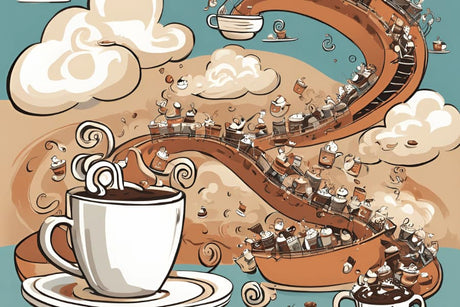“No one's ever achieved financial fitness with a January resolution that's abandoned in February.” — Suze Orman
February 2018 mycuppa Newsletter
It's hot all around Australia, and this month, we discuss what can happen to roasted coffee when exposed to heat.
What's going on with Sendle?
Yep, the rollercoaster ran off the rails and crashed.
We've had a gut full of the ridiculous problems and dramas Sendle caused daily, so it's switched off for keeps.
Ironically, we still have customers demanding we switch it back - read our reasons why we say goodbye to Sendle.
heat and roasted coffee
It's no coincidence this month's article focuses on the impact of heat on coffee quality - specifically roasted coffee.
This summer has been a scorching period for Melbourne, reminiscent of the extreme heat in 2009, 2011 and 2014.
My wife and co-workers suspect I suffer from an undiagnosed weather monitoring affliction.
I'm constantly watching, measuring and sensing the temperature - even in winter!
During the day, roller doors can be opened or closed, extraction ventilators can be switched on, and the cool room temperature can be adjusted for roasted products or warehouse cooling systems.
Apparently, I'm known to never last more than 30 minutes without trying to do something that keeps the temperature in our working environment under better control.
We hold a lot of raw coffees, and whilst these products are less susceptible to quality degradation from heat exposure compared to roasted coffees, the most dedicated and committed coffee roasters will have tight controls over the temperatures of their raw coffee storage.
Heck, the most extreme roasters spend weekends and nights babysitting raw coffee with coolers during hot spells, and sadly, that's my gig on those hot days.
When it comes to roasted coffees, we don't hold our roasted products for more than a day in most cases, but it's still critically important to reduce or eliminate exposure of the fragile and delicate roasted product to high levels of heat.
For these products, we store them, even for just a few hours from packing to dispatch, in a temperature-controlled environment.
So, what happens when roasted coffee is subjected to heat?
Firstly, we probably need to define some metrics - what I call heat is anything over 25 degrees C (some would say that's paradise).
Ideal storage conditions for roasted coffee are between 12 - 20 deg C, but of course, this is not always practical in warm climates or the summer seasons, and it's damn difficult during hot spells.
When it's warm, or what we call hot weather, roasted coffee experiences accelerated oxidisation.
That is, the process of "staling" increases, and in particular, the most noticeable side-effect is a rapid rise in the production of CO2 inside the container or packaging.
This CO2 is the by-product of the development process that occurs with fresh roasted coffee, otherwise known as "off-gassing".
Excessive gas in itself is not necessarily a bad thing, and in short exposure to heat, it won't affect the flavour of the prepared beverage, but prolonged exposure to heat has a negative effect upon the roasted coffee in that it will taste flat, dull, lifeless, lacking aroma, crema and body.
A good friend of mine who owns a coffee business called me recently asking for help and advice on some defects that had recently appeared in his roasted coffee products.
My very first question to him was asking where they stored their roasted coffee and how hot it currently was in that location.
After some explanation and ideas on how to put a solution in place, my friend tested the coffee under changed conditions, and sure enough, the defect was eliminated.
Besides the increased off-gassing caused by higher ambient heat, there may also be other visual cues, such as increased oil migration from the core of the bean to the outer surface, and as we know, oily beans go rancid within minutes from exposure to oxygen (the exception here, of course, is decaf, it's literally impossible to prevent decaf oiling up, even in winter).
Heat results in coffee's lifecycle effectively shortening, and in extreme cases, the coffee may not develop its full potential we are accustomed to experiencing in the first 14 days from roasting - there may be a lemony note in the coffee that is not unpleasant, but it's not delicious.
Sometimes, higher levels of gas (CO2) are due to the production processes (packing straight after roasting) or the variability in relief pressures of the 1-way valve used in the construction of coffee bag packaging, e.g. valves don't all "fire or release" at the same relative pressures and some "stick" causing the bag to swell.
We are often asked if it's OK to store roasted coffee in the fridge, and the simple answer has always been a resounding no.
This article is not going to debate the science of fridge or freezer storage, but the bottom line is, please don't store coffee in the fridge (we still get people calling up wanting to argue or debate the point based upon their "experiments").
By the way, I am also not a fan of storing coffee in the freezer, and I've wasted countless hours discussing this at length with people who are staunch supporters of placing their coffee in the fridge/freezer.
The best solution is to purchase a small esky or one of those soft insulated drink bags and store your coffee in the bottom of the pantry.
It's important to maintain relatively stable temperatures for coffee rather than swinging from low high and back to low in a short period - after all, coffee is a delicate ingredient.
Switched off and staying off
OK, this is the last Sendle update - it's switched off, and we won't be flicking it back on again anytime soon.
In an ideal world, mycuppa would be offering customers delivery choices.
That is, freedom to select a shipping provider based on variable criteria - speed, price, features, trust, etc. - however like we have so often reported in the past, Australia remains hamstrung with a monopoly provider and sub-standard grades of service.
Despite all the marketing and media commentary around new entrants, there continues to be a distinct lack of viable, enterprise-grade competitive providers in the residential freight segment.
Most of the business freight providers "pretend" to do residential - in reality, they can't because of the infrastructure required to deal with futile deliveries.
In striving to offer delivery choices, we genuinely gave Sendle our best shot for more than four months despite numerous setbacks.
We implemented major changes to our business processes to accommodate Sendle's inconsistent collections and outlaid plenty of $ money to patch up potentially strained relationships with our customers who experienced incidents - through no fault of our own service.
We did all of this because logistics providers failed to deliver what we all regard as their basic service obligation.
Whilst we understand many of our customers were happy with the price and/or speed of the Sendle service, quite frankly, there were just way too many incidents - with the majority ending up as serious problems requiring hours of our time to support through resolution.
Sending more than 27,000 parcels a year around Australia, we are always going to see incidents, but not a massive 900% increase in delivery failures - those sorts of numbers just throw us and our customers under the bus.
Putting aside high rates of delivery incidents and not being able to speak directly to Sendle support staff, the final straw came from Sendle's ongoing failure to collect customer parcels on a consistent daily basis.
There is absolutely no justification for such a complete and utter failure.
We highlighted this problem in December as it was an issue occurring behind the scenes, and despite numerous attempts to resolve it, the problem was getting worse every week.
For merchants, failing to pick up customer parcels has horrific consequences as customers have rightful expectations their orders are sent on the way ASAP.
In my opinion, Sendle is just a simple, basic consumer-grade product - it's designed for individuals, not merchants, and it's certainly not enterprise-grade or comparable to AusPost's parcel service, particularly outside of the State capital metro areas.
Others may argue or disagree, but the proof is when you walk in our shoes and feel the pain of delivery incidents.
It will come as a big surprise, but our trusty postie, AusPost, continues to perform with the lowest incident rates.
AusPost offers the broadest reach with the most consistent service quality, and more importantly, AusPost provides the most features and options for those times when a futile delivery attempt occurs.
AusPost are not perfect and, at times, frustrating when they won't deliver and expect recipients to attend an LPO to collect, but across our Australian and New Zealand customers, they are the most reliable service, which, at the end of the day, is fundamental to any merchant.









